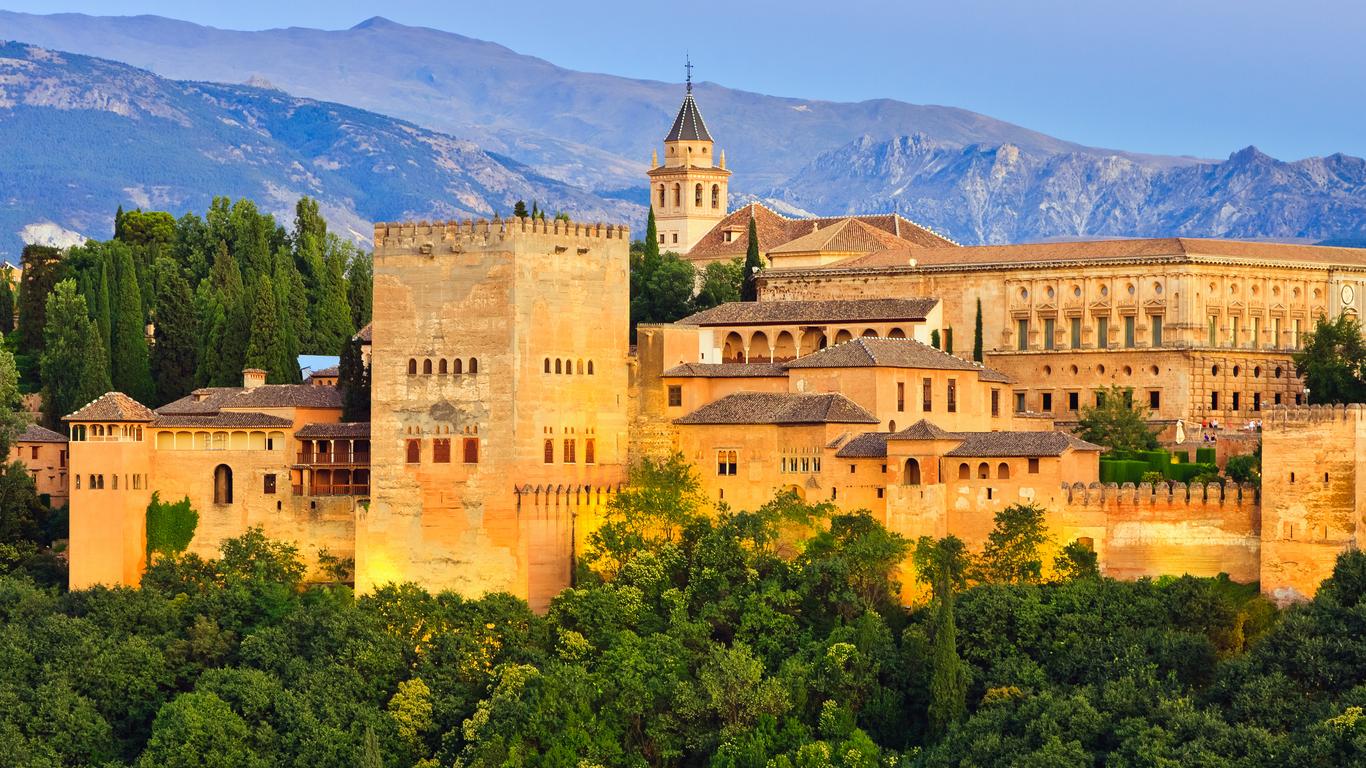
Welcome to Granada, a mesmerizing city nestled in the heart of Andalusia, Spain. With its rich history, stunning architecture, and vibrant culture, Granada is a destination that captivates the hearts of all who visit. From the iconic Alhambra Palace to the winding streets of the Albayzín neighborhood, there is an abundance of beauty and charm waiting to be explored. In this article, we will delve into 50 fascinating facts about Granada that will give you a deeper understanding and appreciation for this enchanting city. Whether you’re planning a trip or simply curious about this Spanish gem, these facts will paint a vivid picture of Granada’s past, present, and everything in between. So grab a cup of tinto de verano and let’s embark on a journey through the wonders of Granada!
Key Takeaways:
- Granada’s rich history, diverse culture, and stunning landscapes make it a must-visit destination. From the iconic Alhambra to the vibrant Flamenco scene, the city offers a unique blend of historical charm and modern allure.
- With its free tapas, breathtaking views, and vibrant arts scene, Granada is a paradise for food lovers, history enthusiasts, and art aficionados alike. The city’s Moorish influence and UNESCO World Heritage sites make it a captivating Spanish gem.
The Alhambra is the most visited attraction in Granada.
The Alhambra, a stunning palace complex built during the Moorish rule, attracts millions of visitors each year with its intricate architecture and vibrant gardens.
Granada is located in the heart of Andalusia.
Situated at the foot of the Sierra Nevada mountains, Granada offers a unique mix of natural beauty and historical charm.
It was founded by the Romans.
Granada has a rich history that dates back to Roman times when it was known as “Illiberis.
The city’s name comes from the Arabic word “Qarnata.”
Granada’s Arabic name means “hill of strangers” and reflects its diverse cultural heritage.
Granada was the last Muslim stronghold in Spain.
During the Middle Ages, Granada was the final remnant of the Islamic Al-Andalus empire before it fell to the Catholic Monarchs.
The iconic Generalife Gardens are part of the Alhambra.
The Generalife Gardens, with their exquisite fountains and stunning views of the city, were the summer retreat of the Nasrid rulers.
Granada is known for its vibrant Flamenco scene.
Flamenco, a passionate and expressive Spanish dance form, has deep roots in the culture of Granada.
The Sierra Nevada National Park is a haven for outdoor enthusiasts.
Home to the highest peaks in mainland Spain, the Sierra Nevada National Park offers incredible hiking, skiing, and mountain climbing opportunities.
Granada has a unique mix of architectural styles.
From Moorish palaces to Renaissance cathedrals, Granada’s architecture showcases the influences of various cultures throughout its history.
The city is famous for its delicious tapas culture.
In Granada, tapas are traditionally served for free with every drink, making it a food lover’s paradise.
Federico García Lorca, one of Spain’s greatest poets, was born in Granada.
Lorca’s works continue to inspire and captivate audiences around the world.
Granada is home to the oldest university in Spain.
The University of Granada, founded in 1531, has a prestigious history and attracts students from all over the world.
The Albaicín neighborhood offers stunning views of the Alhambra.
With its narrow winding streets and traditional Moorish architecture, the Albaicín is a must-visit neighborhood in Granada.
Granada has a bustling street art scene.
Walking through the streets of Granada, you’ll encounter vibrant murals and graffiti that add an artistic touch to the city.
Granada was once home to a thriving Jewish community.
The Jewish quarter, known as the Realejo, still preserves the rich history and heritage of the Jewish population.
The Sacromonte neighborhood is famous for its cave dwellings.
Sacromonte is known for its traditional cave houses that are part of the vibrant Flamenco culture in Granada.
Granada’s Cathedral is the fourth-largest in the world.
The Cathedral of Granada, also known as the Cathedral of the Incarnation, is an impressive architectural marvel.
The Albayzín and the Alhambra are UNESCO World Heritage sites.
These two iconic landmarks are recognized for their historical and cultural significance.
Granada has a thriving music and arts scene.
From classical concerts to contemporary art exhibitions, Granada offers a wide range of cultural experiences.
The Moorish bathhouses, known as hammams, are popular attractions in Granada.
Visitors can relax and rejuvenate in these traditional spas that date back to the Moorish era.
The Granada Science Park is a fascinating educational attraction.
Interactive exhibits and engaging displays make science come alive at this unique park.
The city hosts the International Festival of Music and Dance of Granada.
Every summer, Granada becomes a hub for music and dance enthusiasts from around the world.
Granada enjoys a Mediterranean climate.
Mild winters and hot summers make it an ideal destination for year-round outdoor activities.
The city is famous for its vibrant street markets.
From the bustling Alcaicería market to the lively flea markets, Granada’s street markets offer a treasure trove of goods.
Granada has a strong tradition of artisan crafts.
From pottery and textiles to woodwork and leather goods, local artisans showcase their talents throughout the city.
The Carrera del Darro is one of the most picturesque streets in Granada.
Lined with historic buildings and offering stunning views of the Alhambra, this street is a photographer’s dream.
Granada has a network of underground tunnels.
These tunnels, known as the Catacumbas, were used for water storage and transportation during the Moorish era.
The Arab Baths of El Bañuelo are a hidden gem in Granada.
These well-preserved medieval baths offer a glimpse into Granada’s Moorish past.
The city is famous for its traditional Sacromonte omelettes.
Made with eggs, potatoes, and locally cured ham, these omelettes are a delicious local specialty.
Granada is known for its enchanting sunsets.
The combination of the Sierra Nevada mountains and the Alhambra creates a spectacular backdrop for stunning sunset views.
The Palace of Charles V is an architectural masterpiece.
This Renaissance building, located within the Alhambra complex, is a testament to Granada’s historical significance.
Granada is famous for its traditional flamenco caves.
These unique venues offer an intimate setting to experience authentic flamenco performances.
The city is home to several prestigious festivals.
From the Corpus Christi processions to the Granada International Jazz Festival, there’s always something exciting happening in Granada.
Granada has its own dialect of Spanish.
Known as “Andalusian Spanish,” the local dialect adds a unique charm to the city’s linguistic landscape.
The San Nicolás Viewpoint offers panoramic views of the Alhambra.
Located in the Albaicín neighborhood, this viewpoint provides an unforgettable backdrop for photographs.
Granada has inspired many artists and poets.
From Washington Irving to Lorca, the city’s beauty and allure have captured the imagination of creative minds throughout history.
The Granada Charterhouse is a masterpiece of Baroque architecture.
This monastery, located just outside the city, is a testament to Granada’s religious heritage.
The city is famous for its vibrant Semana Santa celebrations.
During Holy Week, the streets of Granada come alive with elaborate processions and religious fervor.
Granada is a gateway to the Sierra Nevada Ski Resort.
With its close proximity to the mountains, Granada offers easy access to world-class skiing and snowboarding slopes.
The city has a rich literary history.
From the works of Lorca to the poetry of Ibn al-Khatib, Granada has been a muse for many renowned writers.
The Casa Museo Federico García Lorca celebrates the life and work of the famous poet.
Located in his childhood home, this museum offers insights into Lorca’s artistic journey.
Granada is a UNESCO City of Literature.
The city’s vibrant literary scene and commitment to promoting literature led to its inclusion in the UNESCO Creative Cities Network.
Granada has a strong historical connection to the Romani people.
Sacromonte is known for its flamenco performances that honor the Romani cultural heritage.
The Festival Internacional de Música y Danza is one of Europe’s most prestigious cultural events.
Each year, this festival attracts world-class musicians and dancers to showcase their talents in Granada.
Granada is home to a vibrant student population.
With its renowned university, the city has a youthful energy and a thriving student culture.
The Nasrid Palaces within the Alhambra are a masterpiece of Islamic architecture.
The intricate stucco decorations and delicate tile work showcase the exquisite craftsmanship of the Nasrid dynasty.
Granada has a strong Moorish influence in its cuisine.
From delicious tapas to delicate pastries, the flavors of Granada reflect its multicultural heritage.
The Feria de Granada is a week-long celebration of the city’s culture and traditions.
During this festival, the streets of Granada come alive with music, dancing, and vibrant processions.
Granada has a vibrant nightlife scene.
From cozy taverns to trendy bars, the city offers a wide range of options for nocturnal entertainment.
Granada offers breathtaking views from its numerous miradors.
These lookout points provide stunning vistas of the city and its surrounding landscapes.
With its rich history, vibrant culture, and stunning architecture, Granada truly captures the hearts of all who visit. Whether you’re exploring the enchanting Alhambra or indulging in the city’s gastronomic delights, Granada is a destination that will leave you with unforgettable memories. Plan your trip to experience the wonders of this captivating Spanish city!
Conclusion
Granada is a city rich in history, culture, and natural beauty. With its stunning architecture, vibrant music and dance scene, and delicious cuisine, it offers a truly unique and unforgettable experience for visitors. Whether you’re exploring the Alhambra, wandering through the narrow streets of the Albaicín, or taking in the breathtaking views of the Sierra Nevada mountains, Granada never fails to captivate and inspire. This enchanting city is a must-visit destination for anyone seeking a blend of history, art, and a taste of authentic Spanish culture. So, pack your bags and get ready to immerse yourself in the wonders of Granada.
FAQs
1. How do I get to Granada?
Granada is accessible by air, train, and bus. The Federico García Lorca Granada-Jaén Airport offers domestic and international flights. The city is also well-connected by high-speed train and buses from major Spanish cities.
2. What is the best time to visit Granada?
The best time to visit Granada is during spring (April to June) and autumn (September to November) when the weather is mild. Summers can be hot, especially in July and August. Winter is also a good time to visit, as you can experience the magic of the city without the crowds.
3. Can I visit the Alhambra without a tour?
Yes, it is possible to visit the Alhambra without a tour. However, it is recommended to book your tickets in advance, as there are limited daily entries. A guided tour can enhance your experience by providing valuable insights and historical information.
4. What are some traditional dishes to try in Granada?
Some traditional dishes to try in Granada include tapas such as patatas bravas, jamón ibérico, and boquerones. Don’t miss the chance to try the famous free tapas, where you get a complimentary small dish with your drink order.
5. Are there any outdoor activities in Granada?
Absolutely! Granada is surrounded by natural beauty. You can go hiking in the Sierra Nevada mountains, visit the Alpujarra region for stunning landscapes, or explore the countryside on a bike tour. There are also opportunities for skiing and snowboarding in the winter months.
Granada's allure extends beyond its historical landmarks and vibrant culture. Delve deeper into the city's enigmatic Granada Theatre, captivating Conference and Exhibition Centre, or explore the thrilling world of Granada CF football club. Each attraction holds unique stories waiting to be discovered.
Was this page helpful?
Our commitment to delivering trustworthy and engaging content is at the heart of what we do. Each fact on our site is contributed by real users like you, bringing a wealth of diverse insights and information. To ensure the highest standards of accuracy and reliability, our dedicated editors meticulously review each submission. This process guarantees that the facts we share are not only fascinating but also credible. Trust in our commitment to quality and authenticity as you explore and learn with us.


